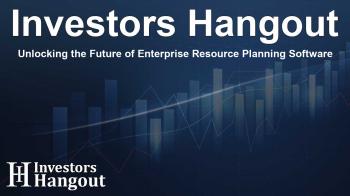Unlocking the Future of Enterprise Resource Planning Software

Exploring the Growth of the Enterprise Resource Planning Software Market
The Enterprise Resource Planning (ERP) software market has become a focal point for businesses aiming to enhance their operations and streamline their processes. With a growing valuation projected to reach USD 175.63 billion, the landscape is shifting dramatically due to several influential factors driving rapid adoption.
Impact of Cloud Adoption and AI Integration
The integration of cloud technology in ERP systems has been a game changer, particularly for small to medium-sized enterprises. Cloud-based solutions offer scalability and flexibility, enabling these businesses to access top-tier ERP functionalities that were once the domain of larger corporations. As more companies embrace hybrid ERP systems, statistics show that upwards of 55% of retailers are enhancing their operations through such integrations.
A Paradigm Shift in Digital Transformation
The COVID-19 pandemic has accelerated the digital transformation journey for many organizations, with nearly 69% of private enterprises acknowledging this shift. Companies are now compelled to leverage real-time analytics and AI-generated insights, facilitating more efficient decision-making processes. For example, industries like manufacturing, retail, and healthcare have seen dramatic enhancements in their workflows as they incorporate advanced technologies like machine learning and the Internet of Things (IoT) into their ERP systems.
Market Dynamics and Demand Drivers
Factors such as the necessity for data-driven decision-making and security through blockchain technology are propelling the ERP market forward. The on-premise ERP sector continues to dominate with a significant market share, providing organizations with the control they desire over their data. However, a noteworthy trend is the rapid growth of cloud ERP systems, which are projected to expand at a CAGR of 13.39% from 2024 through 2032. This reflects businesses’ pursuit of lower costs and faster implementation cycles amid a landscape increasingly shaped by remote work.
Key Segment Insights
Delving into specific segments of the ERP market, finance solutions play a critical role, accounting for around 33% of the total revenue due to their central function in managing a company's financial health. As regulations become more complex, the demand for robust financial ERP solutions has surged. Meanwhile, HR-focused ERP systems are witnessing the fastest growth rate, projected to achieve a CAGR of 14.51% as organizations prioritize employee engagement and talent management.
Geographical Market Dynamics
In terms of geographical market performance, North America has established itself as the leader with approximately 39% of total revenue. This can be attributed to the concentration of major industries deeply invested in ERP solutions. Conversely, the Asia Pacific region is anticipated to show the most promise, with a projected growth rate of 14.85% as digital transformation initiatives soar, particularly in countries like India and China.
Significant Recent Developments
The competitive landscape of the ERP market continues to evolve with key players making strategic moves. For instance, Epicor's acquisition of Smart Software reflects the trend of improving supply chain management through advanced analytics. Additionally, collaborations like that of IBM and KPMG aim to enhance SAP S/4HANA adoption, indicating a robust plan for cloud ERP integration.
Enterprise Resource Planning Software Market Segmentation
In terms of deployment, the market is primarily divided between on-premise and cloud solutions, with both catering to varying enterprise needs. By function, core areas include finance, HR, supply chain, and bespoke solutions tailored to industry-specific challenges. Market segments are further classified by enterprise size, capturing the diverse needs of small, medium, and large enterprises, each requiring tailored solutions that align with their operational demands.
Frequently Asked Questions
What is the projected growth rate of the ERP market?
The ERP market is expected to grow at a CAGR of 12.23% from 2024 to 2032.
How has cloud technology impacted the ERP market?
Cloud technology has democratized access to sophisticated ERP solutions for smaller enterprises, enhancing flexibility and reducing costs.
Which industry segments are driving demand for ERP systems?
Industries like manufacturing, healthcare, and retail are significantly driving the demand for ERP systems, particularly those integrating AI technologies.
What geographical regions show the most ERP growth?
The Asia Pacific region is anticipated to experience the fastest growth in the ERP market due to increased digital transformation efforts.
How do finance and HR segments compare in the ERP market?
The finance segment leads the market share, while the HR segment is the fastest growing, reflecting evolving business priorities.
About Investors Hangout
Investors Hangout is a leading online stock forum for financial discussion and learning, offering a wide range of free tools and resources. It draws in traders of all levels, who exchange market knowledge, investigate trading tactics, and keep an eye on industry developments in real time. Featuring financial articles, stock message boards, quotes, charts, company profiles, and live news updates. Through cooperative learning and a wealth of informational resources, it helps users from novices creating their first portfolios to experts honing their techniques. Join Investors Hangout today: https://investorshangout.com/
Disclaimer: The content of this article is solely for general informational purposes only; it does not represent legal, financial, or investment advice. Investors Hangout does not offer financial advice; the author is not a licensed financial advisor. Consult a qualified advisor before making any financial or investment decisions based on this article. The author's interpretation of publicly available data shapes the opinions presented here; as a result, they should not be taken as advice to purchase, sell, or hold any securities mentioned or any other investments. The author does not guarantee the accuracy, completeness, or timeliness of any material, providing it "as is." Information and market conditions may change; past performance is not indicative of future outcomes. If any of the material offered here is inaccurate, please contact us for corrections.
